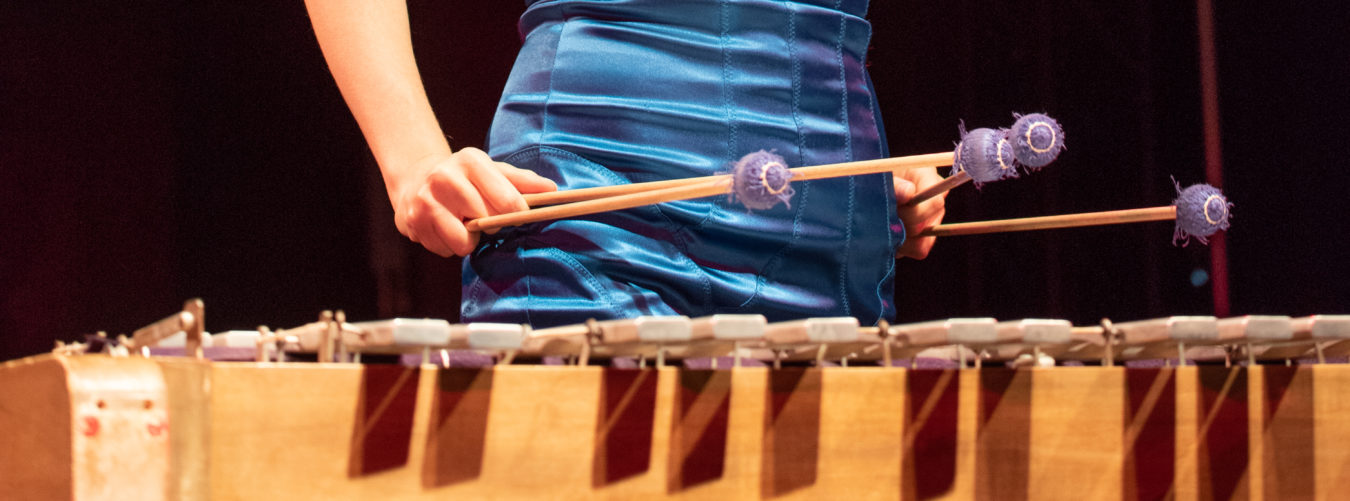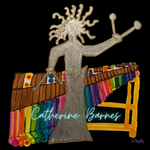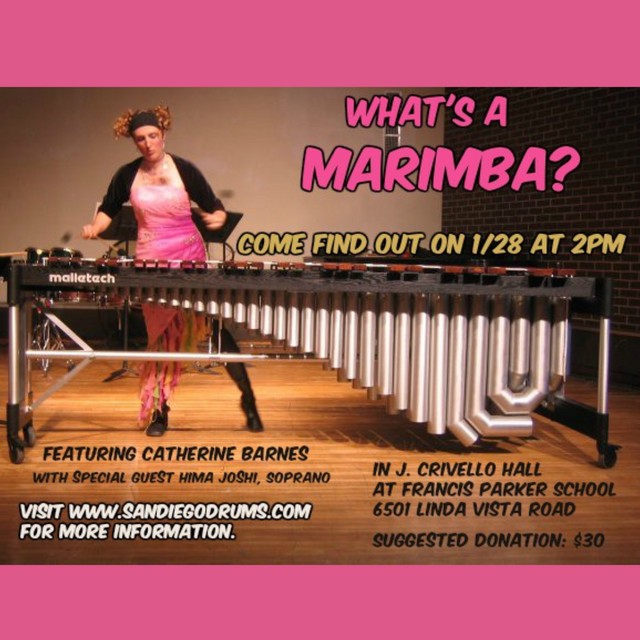#tbt – 2018 Marimba Recital and Fundraiser
From 2004 to 2008, I studied percussion at Northwestern University, where I spent most of my time playing an instrument called the marimba. The marimba is like a giant xylophone genetically engineered to sound like a cello; it has a warm, beautiful tone. I can play it with either two mallets or four mallets.
After graduating from college in 2008, I no longer had access to a five-octave marimba and couldn’t play the repertoire I’d worked so hard to master at Northwestern. In the summer of 2017, I discovered a friend of a friend back in Chicago was selling his five-octave instrument. I knew the time had come; I flew to Chicago, bought the marimba, rented a van, and drove it back to San Diego.
On January 28, 2018, I gave my first marimba performance since 2008. I broadcast it on facebook live (upside-down, as luck would have it!). Using the Amanda Palmer “Art of Asking” method and suggesting a $30 donation, I raised roughly $3000 that I used towards paying off the $10,000 loan on my instrument. If you’d still like to make a donation, the GoFundMe still exists!
You can find the full concert (including talking) and the full concert (without talking) on my YouTube Channel.
Here are the program notes and video recordings for each individual piece:
Bach Cello Suite No. 1 in G
I believe it was Leigh Howard Stevens who really made playing Bach on the marimba a “thing.” I’ve been playing this piece ever since college, and it’s always been one of my favorites. I love this article about whether or not it’s actually possible to perform Baroque dance to the cello suites (short answer: no) and this one about the “interpretational angst” inherent in learning these pieces. I also appreciate Pius Cheng’s thoughts on whether or not it’s appropriate to play Bach on the marimba in the first place [note from 2023: I can’t find these anymore! Bummer!]. My personal opinion is that since there were keyboard instruments at that time, it makes sense to play Bach on a modern keyboard instrument like the marimba. Besides, he is dead…and there really isn’t much he can do about it, anyway.
Back in college, I had a lesson on the G major suite with Evan Wilson, the former principal violist of the Los Angeles Philharmonic. That was my first time ever having a lesson with someone who played a different instrument, and I found it to be very helpful in terms of my musicianship. To prepare for this concert, I had a lesson with my colleague Sarah Gongaware, a cellist. She even brought her cello to the lesson and demonstrated how she would play certain passages. It was great to get insider tips from someone who plays the instrument these were written for.
This will be the first piece I play on my January 28, 2018 marimba concert. Here is my recording of these pieces from the very last marimba concert I did in 2008.
[And here is my recording from 1/28/18:]
Carinhoso
“I never sang “Carinhoso” publicly…only at home…in the shower, like all Brazilian people.”
– Marisa Monte
Carinhoso (“affectionate” in English) is quite possibly one of the most famous (if not the most famous) songs in Brazil. It’s considered a choro, a style of music roughly analogous to ragtime in the United States. The composer, Pixinguinha (say: Pee-sheen-GEEN-ya) – arguably the most famous composer of the genre – wrote the piece in 1917 but didn’t record it until 1928. At the time he wrote it, he was concerned that other musicians wouldn’t accept it because it only had an “A” section and a “B” section; choros at the time were supposed to also have a “C” section and be played in rondo form, “A-B-A-C-A.” When Pixinguinha finally did record it, a critic complained that it had too much American jazz influence. It looked like Carinhoso was headed for obscurity until 1936 when João de Barro, known as “Braguinha,” wrote some lyrics for it. Pixinguinha initially didn’t like them and used a different set written by Pedro Caetano; however, Pixinguinha’s brother Eduardo thought Pedro’s lyrics were “sappy, humorless, and full of obsolete words.” When Pixinguinha was finally persuaded to use Braguinha’s lyrics, the song was an immediate success. (Here is an article in Portuguese that is the source for this information.)
I have been a fan of this song since 2007 when I discovered Marisa Monte and Paulinho da Viola’s recording of it on YouTube. I had a classical guitar transcription that I brought back from Brazil with me, but I lost the second page…and then the first page. I was afraid to arrange it for the marimba myself because it’s such an important and famous song…but I figured someone had to do it. I will make the arrangement available for download as soon as I have it finalized.
This will be the second song that I play on my January 28, 2018 marimba concert.
[and here is my recording from that day:]
Cobalt Blue
One of the great things about working at Francis Parker School is getting to collaborate with other faculty members. I’ve done a few performances with soprano Hima Joshi, who also happens to be our science department chair. I asked if she’d like to perform with me on my January 28th marimba concert, and she suggested this piece. This will be the third selection on the program.
The composer, Ney Rosauro, is also a percussionist. He taught at the University of Miami for many years. Like Pixinguinha, he is also from Rio de Janeiro, Brazil. I’m excited to have two very different Brazilian composers represented on this concert.
Here are Ney Rosauro’s program notes for this piece:
From previous contact with marimba virtuoso Keiko Abe I discovered a beautiful poem from her that described a journey to a world of cobalt blues. I was touched by this text and start singing a melody that was in one point related to a blue note. Keiko suggested that the use a soprano voice to sing this melody and the result was this beautiful song for marimba and voice. The music was written in Florianopolis, Brazil (where the ocean meets the sky) and it reflects well this world of cobalt blues that Keiko described on her text.
I enjoy the “blue notes” he describes in his program notes; however, my favorite thing about this piece is the jazzy walking bass line that happens in the marimba in the third section. See if you can hear that in Katarzyna Mycka and Guadalupe Guillen’s recording.
[and here is my recording from 1/28/18:]
Rumble Strips
Composer and percussionist Gordon Stout offers the following program information for this piece on his website:
The title refers to the warning bumps or grooves that are often encountered on our roadways, which produce a sudden and unexpected rumbling when driven over. These rumble strips are depicted musically throughout the composition.
I first played this piece when I was a sophomore in college. I’m notorious for playing it slower than the written tempos; I think that helps to bring out the funky hemiola patterns that happen in the second movement. I chose to program this piece on this concert because it reminds me of my drive from Chicago to San Diego with my newly purchased marimba disassembled in the back…especially when I got to Arizona, and it started raining.
I haven’t been able to find any recordings of this piece on YouTube that I like enough to post here, so I recommend checking out Gordon Stout‘s recording on his website. She-E Wu also has a recording on her album “Snapshot.” This version is a little too fast for my taste – but she’s the one who premiered it, so I defer to her expertise. This will be the fourth piece on my January 28, 2018 marimba concert.
[Here is the recording:]
Se Me Olvidó Otra Vez
When I was in high school, my Spanish teacher made me a CD. “I’ll make sure it has lots of drums on it for you,” she said. This CD quickly became one of my favorites, and I listened to it for years. I could mimic the sounds of the lyrics even if I wasn’t really sure what they were saying all the time. However, there finally came a day when I could understand entire songs. This was the first one. I loved how the song had such sad lyrics, but the band played it at such an energetic tempo.
Years later, I discovered the song was a cover. I was hesitant to watch the original version because I figured it couldn’t live up to the one I had already loved for so many years, but when I finally did, I became one of Juan Gabriel’s many fans. This is the version I used to base my marimba arrangement on.
This will be the final piece I play on my January 28, 2018 marimba concert. It is a dream come true for me to perform this song on the marimba. As I play, I will be thinking about the lyrics. For those of you who don’t speak Spanish, here is my own imperfect translation:
You’ve probably already forgotten me
And in the meantime, I keep waiting for you
I haven’t wanted to go in case someday
If you wanted to come back, you’d still find me
That’s why I’m still in the same place as always
The same city and with the same people
So that when you come back, you won’t find anything strange
And it will be like yesterday, and we won’t leave each other anymore
I’m probably asking too much
I had forgotten that we had already finished
That you’ll never come back; that you never loved me
But I forgot once again that I only loved you.
[Recording:]


